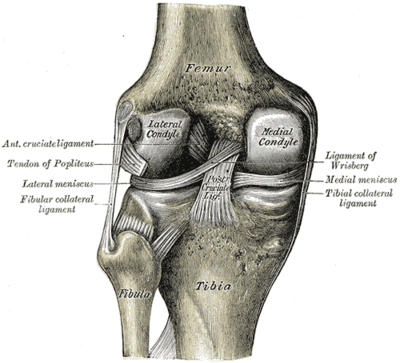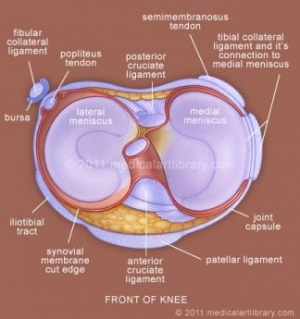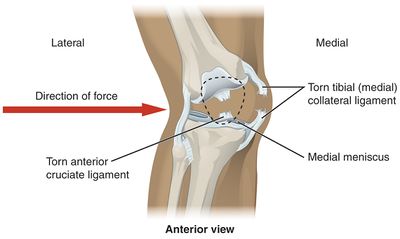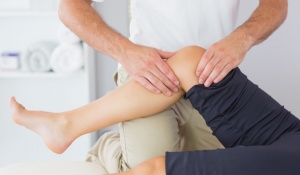Medial Collateral Ligament of the Knee: Difference between revisions
No edit summary |
Kim Jackson (talk | contribs) m (Text replacement - "[[Medial meniscus" to "[[Medial Meniscus") |
||
| (20 intermediate revisions by 8 users not shown) | |||
| Line 1: | Line 1: | ||
<div class="editorbox"> | <div class="editorbox"> | ||
'''Original Editor '''- Rebecca Wilson | '''Original Editor '''- [[User:Rebecca Wilson|Rebecca Wilson]] | ||
'''Top Contributors''' - {{Special:Contributors/{{FULLPAGENAME}}}} | '''Top Contributors''' - {{Special:Contributors/{{FULLPAGENAME}}}} | ||
| Line 6: | Line 6: | ||
== Description == | == Description == | ||
The MCL is one of four major ligaments that supports the knee. | [[Image:MCL1.png|right|400x400px|frameless]]The medial collateral ligament (MCL) is a flat band of connective tissue that runs from the medial epicondyle of the [[femur]] to the medial condyle of the [[tibia]] and is one of four major ligaments that supports the knee. MCL injuries often occur in sports, being the most common ligamentous injury of the knee, and 60% of skiing knee injuries involve the MCL)<ref>Naqvi U. [https://www.ncbi.nlm.nih.gov/books/NBK431095/ Medial Collateral Ligament (MCL) Knee] Injuries.4.6.2019 Available from:https://www.ncbi.nlm.nih.gov/books/NBK431095/ (last accessed 1.3.2020)</ref>. | ||
NB The MCL is also known as the tibial collateral ligament (see image) | |||
The MCL | |||
* Provides valgus stability to the [[Knee|knee joint]]. | |||
* Is a strong broad band<ref name="atk">Atkins, E., Kerr, J. & Goodland, E., 2015. A Practical Approach to Musculoskeletal Medicine: Assessment, Diagnosis, Treatment. 4th ed. China: Elsevier.</ref> found on the inner aspect of the knee joint and is the largest structure situated on the medial side.<ref name="lap">Laprade, R. F., et al., 2007. The Anatomy of the Medial Part of the Knee. Journal of Bone and Joint Surgery [online]. 89(9), pp. 2000-2010. [viewed 12 September 2016]. Available from: http://jbjs.org/content/89/9/2000</ref> | |||
* The most common [[Medial Collateral Ligament Injury of the Knee|ligament injury]] of the knee.<ref name="che">Chen, L. et al., 2008. Medial collateral ligament injuries of the knee: current treatment concepts. Current Reviews in Musculoskeletal Medicine [online]. 1(2), pp. 108-113. [viewed 12 September 2016]. Available from: http://www.ncbi.nlm.nih.gov/pmc/articles/PMC2684213/</ref> | |||
This structure is divided into superficial and deep ligaments. | |||
* The superficial ligament is also known as the tibiofemoral ligament<ref name="lap" /> | |||
* The deep ligament is identified as the mid-third capsular ligament.<ref name="phi">Phisitkul, P. et al., 2006. MCL Injuries of the Knee: Current Concepts Review. The IOWA Orthopaedic Journal [online]. 26, pp. 77-90. [viewed 12 September 2016]. Available from: http://www.ncbi.nlm.nih.gov/pmc/articles/PMC1888587/</ref> | |||
== Attachments == | == Attachments == | ||
[[File:Knee-joint-meniscus.jpg|right|frameless]] | |||
#The superficial medial collateral ligament (sMCL) has one femoral and two tibial attachments.<ref name="lap" /> | |||
* The femoral attachment is situated on the medial epicondyle. | |||
* The proximal attachment 1. blends into [[semimembranosus]] tendon and 2. distal attachment is at the posteromedial crest of the tibia.<ref name="lap" /> | |||
2. The Deep medial ligament (dMCL) is divided into two, the meniscofemoral and meniscotibial ligaments.<ref name="duf">Duffy, P. & Miyamoto, R. G. 2010. Management of Medial Collateral Ligament Injuries in the Knee: An Update and Review. The Physician and Sportsmedicine [online]. 38(2), pp. 39-54. [viewed 12 September 2016]. Available from: http://www.ncbi.nlm.nih.gov/pubmed/20631463</ref> | |||
* The origin of the meniscofemoral comes from the femur just distal to the superficial medial collateral, inserting into the [[Medial Meniscus|medial menisci]].<ref name="duf" /> | |||
* The meniscotibial ligament is thicker and shorter. It travels from the medial meniscus to the distal edge of the articular cartilage of the medial tibial plateau.<ref name="duf" /> | |||
== Function == | |||
The medial collateral ligament is recognised as being a primary static stabiliser of the knee<ref name="che" /><ref name="mar">Markatos, K. & Tzagk, G. 2016. The anatomy of the medial collateral ligament of the knee and its significance in joint stability. Journal of Anatomy and Embryology [online]. 121(2), pp. 198-204. [viewed 12 September 2016]. Available from: http://www.fupress.net/index.php/ijae/article/view/18495</ref> and assists in passively stabilising the joint. | |||
The superficial | The superficial and deep ligaments each have a unique function, making the MCL the primary responder to valgus stress and a secondary restraint to rotational forces. | ||
* The sMCL, specifically the proximal division, resists valgus forces through all degrees of knee flexion. The distal division of the sMCL helps stabilize external rotation of the knee at 30-degree flexion. | |||
* The dMCL helps stabilize internal rotation of the knee from full extension through 90-degree flexion (assists the knee in rotational stability primarily in extension moving through into early flexion).<ref name="cav">Cavignac, E. et al., 2015. The Role of the Deep Medial Collateral Ligament in controlling rotational stability of the knee. Knee Surgery, Sports Traumatology, Arthoscopy [online]. 23(10), pp. 3101-3107. [viewed 20 September 2016]. Available from: http://www.ncbi.nlm.nih.gov/pubmed/24894123</ref>. Despite the relationship of the dMCL with the medial meniscus, there is no influence of the MCL on the stability of the medial meniscus | |||
Together, the MCL also helps guide the knee joint through its full range of motion when a tensile load is applied. | |||
* With low load, the ligament is relatively compliant; with increasing load, the ligament responds with increasing stiffness until it is nearly linear. Beyond this, the MCL will continue to absorb energy until failure. | |||
The MCL also prevents hyperextension of the joint and posterior translation of the tibia, secondary to the function of the posterior cruciate ligament (PCL). The posterior oblique ligament, a continuum of oblique fibers at the posterior aspect of the MCL, is responsible for this function. | |||
The | The ligament also plays a role in joint position sense or proprioceptive feedback. When the MCL is stretched beyond its ability or exposed to an excessive load, it evokes neurological feedback signals that then generate a muscle contraction.<ref name=":0">Juneja P, Hubbard JB. [https://www.ncbi.nlm.nih.gov/books/NBK507780/#article-36091.s2 Anatomy, Bony Pelvis and Lower Limb, Knee Medial Collateral Ligament.]dec 6 2018 Available from:https://www.ncbi.nlm.nih.gov/books/NBK507780/#article-36091.s2 (last accessed 1.3.2020)</ref> | ||
== | == Blood Supply == | ||
Branches of the superior and inferior genicular arteries supply the MCL. The area near the bony insertions is more richly vascularized.<ref name=":0" /> | |||
== Nerves == | |||
The MCL is innervated by the medial articular nerve, a branch of the [[Gonalgia paresthetica|saphenous nerve]]. | |||
* Innervation is greatest in the epiligament and near the insertions. | |||
* The ligament can perceive pain and process proprioception through specialized sensory mechanoreceptors like Ruffini endings, Pacinian corpuscles, Golgi receptors, and bare nerve endings. | |||
* Complete MCL tears will completely disrupt the pattern of innervation<ref name=":0" />. | |||
== Clinical Relevance == | == Clinical Relevance == | ||
The MCL is one of the most commonly injured ligaments of the knee. | |||
* Valgus stress is the most common mechanism of injury. | |||
* Injuries can be contact (a direct blow to the outer aspect of the lower thigh or upper leg) or non-contact (common in skiing). Contact injuries are usually more severe.<ref name=":0" /> | |||
[[Image:MCL2.jpg|right|400x400px|frameless]]Injuries to the MCL can have detrimental effects to surrounding structures. | |||
* It is recognised that either partial or complete ruptures in the ligament significantly increases the load on the ACL. | |||
* Partial tears show that increases in ACL load were identified at 30 degree knee flexion and valgus load and internal torque.<ref name="bat">Battaglia, M. J. et al., 2009. Medial Collateral Ligament Injuries and Subsequent Load on the Anterior Cruciate Ligament: A Biomechnical Evaluation in a Cadaveric Model. The American Journal of Sports Medicine [online], 37(2), pp. 305-311. [viewed 13 September 2016]. Available from: http://www.ncbi.nlm.nih.gov/pubmed/19098154</ref> | |||
* The medial meniscus is often also injured due to its relationship with the dMCL<ref name=":0" /> | |||
== Assessment == | == Assessment == | ||
Assessment of the MCL is best within 20 to 30 minutes of injury before pain, swelling, and muscle spasms make examination difficult. The assessment includes palpation and a special test, the valgus stress test VST | |||
# Palpation | |||
The anterior aspect of the ligament can be palpated moving vertically, roughly midway along the medial joint line. Focal tenderness indicates an MCL injury.<ref name="atk" /> | |||
2. Special test | |||
The | The VST assesses laxity of the MCL compared to the contralateral knee as a control. An increase in laxity and joint space usually distinguishes damage to the medical collateral ligament.<ref>Luke, A., no date. Sports Medicine: Knee Physical Examination [online]. Department of Orthopedic Surgery. [viewed 14 September 2016]. Available from: http://orthosurg.ucsf.edu/patient-care/divisions/sports-medicine/conditions/physical-examination-info/knee-physical-examination/</ref> | ||
=== | The patient should be positioned supine. | ||
* Perform with the knee in approximately 30 degrees flexion rather than extension, ensuring isolated testing of the MCL (flexion helps to relax surrounding structures including the posterior capsule).<ref name="ros">Rossi, R. et al., 2011. Clinical examination of the knee: know your tools for diagnosis of knee injuries. BMC Sports Science, Medicine and Rehabilitation [online]. 3(25), pp. 1-10. [viewed 13 September 2016]. Available from: http://link.springer.com/article/10.1186/1758-2555-3-25</ref> | |||
* Therapists position one hand on the lateral aspect of the joint line of the knee with the other hand on the medial aspect of the ankle. | |||
* A valgus force is then applied, a positive result of the knee in this position would be an increase in joint space medially.<ref name="ros" /> | |||
When assessing for an MCL injury, the examiner should carefully inspect surrounding structures. Suspicion of additional injury may require imaging.<ref name=":0" /> | |||
=== Treatment === | |||
[[File:Manual Therapy to knee joint.jpg|right|frameless]] | |||
Treatment is often non-operative because the MCL has strong vascular support for healing<ref name=":0" />. See [[Medial Collateral Ligament Injury of the Knee|Medial Collateral Ligament Injury.]] | |||
* | |||
== Resources == | == Resources == | ||
| Line 43: | Line 88: | ||
== See also == | == See also == | ||
*[http://www.physio-pedia.com/Knee Knee] | *[http://www.physio-pedia.com/Knee Knee] | ||
*[[ | *[[Anterior Cruciate Ligament (ACL)|Anterior cruciate ligament]] | ||
*[[ | *[[Medial Meniscus|Medial meniscus]] | ||
*[[ | *[[Medial Collateral Ligament Injury of the Knee|MCL injuries]] | ||
*[[Pellegrini- | *[[Pellegrini-Stieda syndrome|Pellegrini-Stieda syndrome]] | ||
*[http://www.physio-pedia.com/Diagnostic_Imaging_of_the_Knee_for_Physical_Therapists#Medial_Collateral_.28MCL.29_and_Lateral_Collateral_Ligament_.28LCL.29_Tears Diagnostic imaging of the knee]<div class="researchbox"></div> | |||
== References == | |||
== References | |||
<references /> | <references /> | ||
[[Category:Anatomy]] | |||
[[Category:Ligaments]] | |||
[[Category:Knee]] | |||
[[Category:Knee - Anatomy]] | |||
[[Category:Knee - Ligaments]] | |||
[[Category:Course Pages]] | |||
Latest revision as of 11:04, 22 January 2024
Original Editor - Rebecca Wilson
Top Contributors - George Prudden, Kim Jackson, Lucinda hampton, 127.0.0.1, WikiSysop, Vidya Acharya, Rucha Gadgil and Saimat Lachinova
Description[edit | edit source]
The medial collateral ligament (MCL) is a flat band of connective tissue that runs from the medial epicondyle of the femur to the medial condyle of the tibia and is one of four major ligaments that supports the knee. MCL injuries often occur in sports, being the most common ligamentous injury of the knee, and 60% of skiing knee injuries involve the MCL)[1].
NB The MCL is also known as the tibial collateral ligament (see image)
The MCL
- Provides valgus stability to the knee joint.
- Is a strong broad band[2] found on the inner aspect of the knee joint and is the largest structure situated on the medial side.[3]
- The most common ligament injury of the knee.[4]
This structure is divided into superficial and deep ligaments.
- The superficial ligament is also known as the tibiofemoral ligament[3]
- The deep ligament is identified as the mid-third capsular ligament.[5]
Attachments[edit | edit source]
- The superficial medial collateral ligament (sMCL) has one femoral and two tibial attachments.[3]
- The femoral attachment is situated on the medial epicondyle.
- The proximal attachment 1. blends into semimembranosus tendon and 2. distal attachment is at the posteromedial crest of the tibia.[3]
2. The Deep medial ligament (dMCL) is divided into two, the meniscofemoral and meniscotibial ligaments.[6]
- The origin of the meniscofemoral comes from the femur just distal to the superficial medial collateral, inserting into the medial menisci.[6]
- The meniscotibial ligament is thicker and shorter. It travels from the medial meniscus to the distal edge of the articular cartilage of the medial tibial plateau.[6]
Function[edit | edit source]
The medial collateral ligament is recognised as being a primary static stabiliser of the knee[4][7] and assists in passively stabilising the joint.
The superficial and deep ligaments each have a unique function, making the MCL the primary responder to valgus stress and a secondary restraint to rotational forces.
- The sMCL, specifically the proximal division, resists valgus forces through all degrees of knee flexion. The distal division of the sMCL helps stabilize external rotation of the knee at 30-degree flexion.
- The dMCL helps stabilize internal rotation of the knee from full extension through 90-degree flexion (assists the knee in rotational stability primarily in extension moving through into early flexion).[8]. Despite the relationship of the dMCL with the medial meniscus, there is no influence of the MCL on the stability of the medial meniscus
Together, the MCL also helps guide the knee joint through its full range of motion when a tensile load is applied.
- With low load, the ligament is relatively compliant; with increasing load, the ligament responds with increasing stiffness until it is nearly linear. Beyond this, the MCL will continue to absorb energy until failure.
The MCL also prevents hyperextension of the joint and posterior translation of the tibia, secondary to the function of the posterior cruciate ligament (PCL). The posterior oblique ligament, a continuum of oblique fibers at the posterior aspect of the MCL, is responsible for this function.
The ligament also plays a role in joint position sense or proprioceptive feedback. When the MCL is stretched beyond its ability or exposed to an excessive load, it evokes neurological feedback signals that then generate a muscle contraction.[9]
Blood Supply[edit | edit source]
Branches of the superior and inferior genicular arteries supply the MCL. The area near the bony insertions is more richly vascularized.[9]
Nerves[edit | edit source]
The MCL is innervated by the medial articular nerve, a branch of the saphenous nerve.
- Innervation is greatest in the epiligament and near the insertions.
- The ligament can perceive pain and process proprioception through specialized sensory mechanoreceptors like Ruffini endings, Pacinian corpuscles, Golgi receptors, and bare nerve endings.
- Complete MCL tears will completely disrupt the pattern of innervation[9].
Clinical Relevance[edit | edit source]
The MCL is one of the most commonly injured ligaments of the knee.
- Valgus stress is the most common mechanism of injury.
- Injuries can be contact (a direct blow to the outer aspect of the lower thigh or upper leg) or non-contact (common in skiing). Contact injuries are usually more severe.[9]
Injuries to the MCL can have detrimental effects to surrounding structures.
- It is recognised that either partial or complete ruptures in the ligament significantly increases the load on the ACL.
- Partial tears show that increases in ACL load were identified at 30 degree knee flexion and valgus load and internal torque.[10]
- The medial meniscus is often also injured due to its relationship with the dMCL[9]
Assessment[edit | edit source]
Assessment of the MCL is best within 20 to 30 minutes of injury before pain, swelling, and muscle spasms make examination difficult. The assessment includes palpation and a special test, the valgus stress test VST
- Palpation
The anterior aspect of the ligament can be palpated moving vertically, roughly midway along the medial joint line. Focal tenderness indicates an MCL injury.[2]
2. Special test
The VST assesses laxity of the MCL compared to the contralateral knee as a control. An increase in laxity and joint space usually distinguishes damage to the medical collateral ligament.[11]
The patient should be positioned supine.
- Perform with the knee in approximately 30 degrees flexion rather than extension, ensuring isolated testing of the MCL (flexion helps to relax surrounding structures including the posterior capsule).[12]
- Therapists position one hand on the lateral aspect of the joint line of the knee with the other hand on the medial aspect of the ankle.
- A valgus force is then applied, a positive result of the knee in this position would be an increase in joint space medially.[12]
When assessing for an MCL injury, the examiner should carefully inspect surrounding structures. Suspicion of additional injury may require imaging.[9]
Treatment[edit | edit source]
Treatment is often non-operative because the MCL has strong vascular support for healing[9]. See Medial Collateral Ligament Injury.
Resources[edit | edit source]
See also[edit | edit source]
- Knee
- Anterior cruciate ligament
- Medial meniscus
- MCL injuries
- Pellegrini-Stieda syndrome
- Diagnostic imaging of the knee
References[edit | edit source]
- ↑ Naqvi U. Medial Collateral Ligament (MCL) Knee Injuries.4.6.2019 Available from:https://www.ncbi.nlm.nih.gov/books/NBK431095/ (last accessed 1.3.2020)
- ↑ 2.0 2.1 Atkins, E., Kerr, J. & Goodland, E., 2015. A Practical Approach to Musculoskeletal Medicine: Assessment, Diagnosis, Treatment. 4th ed. China: Elsevier.
- ↑ 3.0 3.1 3.2 3.3 Laprade, R. F., et al., 2007. The Anatomy of the Medial Part of the Knee. Journal of Bone and Joint Surgery [online]. 89(9), pp. 2000-2010. [viewed 12 September 2016]. Available from: http://jbjs.org/content/89/9/2000
- ↑ 4.0 4.1 Chen, L. et al., 2008. Medial collateral ligament injuries of the knee: current treatment concepts. Current Reviews in Musculoskeletal Medicine [online]. 1(2), pp. 108-113. [viewed 12 September 2016]. Available from: http://www.ncbi.nlm.nih.gov/pmc/articles/PMC2684213/
- ↑ Phisitkul, P. et al., 2006. MCL Injuries of the Knee: Current Concepts Review. The IOWA Orthopaedic Journal [online]. 26, pp. 77-90. [viewed 12 September 2016]. Available from: http://www.ncbi.nlm.nih.gov/pmc/articles/PMC1888587/
- ↑ 6.0 6.1 6.2 Duffy, P. & Miyamoto, R. G. 2010. Management of Medial Collateral Ligament Injuries in the Knee: An Update and Review. The Physician and Sportsmedicine [online]. 38(2), pp. 39-54. [viewed 12 September 2016]. Available from: http://www.ncbi.nlm.nih.gov/pubmed/20631463
- ↑ Markatos, K. & Tzagk, G. 2016. The anatomy of the medial collateral ligament of the knee and its significance in joint stability. Journal of Anatomy and Embryology [online]. 121(2), pp. 198-204. [viewed 12 September 2016]. Available from: http://www.fupress.net/index.php/ijae/article/view/18495
- ↑ Cavignac, E. et al., 2015. The Role of the Deep Medial Collateral Ligament in controlling rotational stability of the knee. Knee Surgery, Sports Traumatology, Arthoscopy [online]. 23(10), pp. 3101-3107. [viewed 20 September 2016]. Available from: http://www.ncbi.nlm.nih.gov/pubmed/24894123
- ↑ 9.0 9.1 9.2 9.3 9.4 9.5 9.6 Juneja P, Hubbard JB. Anatomy, Bony Pelvis and Lower Limb, Knee Medial Collateral Ligament.dec 6 2018 Available from:https://www.ncbi.nlm.nih.gov/books/NBK507780/#article-36091.s2 (last accessed 1.3.2020)
- ↑ Battaglia, M. J. et al., 2009. Medial Collateral Ligament Injuries and Subsequent Load on the Anterior Cruciate Ligament: A Biomechnical Evaluation in a Cadaveric Model. The American Journal of Sports Medicine [online], 37(2), pp. 305-311. [viewed 13 September 2016]. Available from: http://www.ncbi.nlm.nih.gov/pubmed/19098154
- ↑ Luke, A., no date. Sports Medicine: Knee Physical Examination [online]. Department of Orthopedic Surgery. [viewed 14 September 2016]. Available from: http://orthosurg.ucsf.edu/patient-care/divisions/sports-medicine/conditions/physical-examination-info/knee-physical-examination/
- ↑ 12.0 12.1 Rossi, R. et al., 2011. Clinical examination of the knee: know your tools for diagnosis of knee injuries. BMC Sports Science, Medicine and Rehabilitation [online]. 3(25), pp. 1-10. [viewed 13 September 2016]. Available from: http://link.springer.com/article/10.1186/1758-2555-3-25










